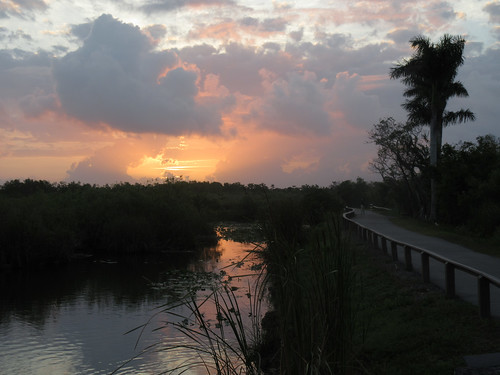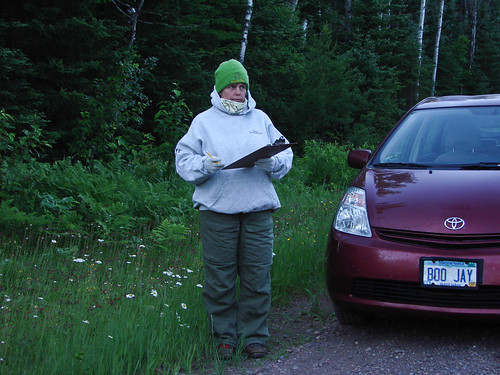People often ask me if it is really necessary to get up while it’s still dark to watch birds. And I always reassure them that of course not—I see a good number of birds whenever I start out in the day, including the afternoon.
But a special kind of magic in the wee hours in spring and early summer ebbs into the ordinary as the sun emerges. It only partly involves the number of species: if you’re out an hour or half hour before sunrise, you may still be hearing owls; birds most characteristic of twilight such as rails, woodcock, snipe, bitterns, nighthawks, and Le Conte’s Sparrows will be singing and calling and dancing in the sky most reliably; and daytime birds are also piping in, starting and ending with our good old robins, but also including White-throated Sparrows, House Wrens, Brown Thrashers, Baltimore Orioles, Rose-breasted Grosbeaks, and Song and Chipping Sparrows. Sure, if you’re in the right habitat, you can get just about any of these birds later in the morning, except the owls if crows don’t discover them first, but when they first awaken, before it’s light enough to look for breakfast, birds proclaim their existence with a unique and special exuberance before they get caught up in their other daily activities.
The main times in my lifetime that I’ve experienced these pre-dawn choruses have been when I’ve done Big Days, often starting out at 2 am; once a year for two decades when I did my Breeding Bird Surveys; several times a year when I’d stay at my mother-in-law’s in Port Wing, Wisconsin, so I could start out at 4 am on a long and satisfying walk; and during my teaching years in Madison, Wisconsin, when I’d get up at 4 every weekday in April and May to go birding before school started. I obviously couldn’t see many birds in twilight—I usually needed good light to pick out and identify birds visually—but the magical sounds of that pre-dawn chorus started my days with an ethereal beauty I’ve never experienced after the sun comes up.
I took the Cornell Lab of Ornithology’s field recording class in 2001, when Greg Budney was running it and we were staying at a research station in the Sierra Nevadas. That happened to be a year when the extraordinary Donald Kroodsma, an authority on how birds acquire their songs and one of my heroes, was there. At one of our sessions, Greg Budney said we’d be setting out early the next day to experience and record a “dawn chorus.” I’d already experienced plenty of dawn choruses, so I expected him to tell us we’d be getting up at 2, and certainly no later than 3. That was clearly what Don Kroodsma expected, too, but groans from the rest of the group led to a compromise—we wouldn’t even be leaving until 5 am. Sure, that was plenty early to catch a lot of bird song, but it wasn’t the magical experience of a true dawn chorus. (Don reminded me today that he headed up to the site at the proper time and "was finished recording when you all showed up!")
This spring, thanks to the pandemic I haven’t been able to get to any of my beloved places where warblers or Le Conte’s Sparrows abound. And I’m 68 now, way older than I was when I was teaching in my 20s or wending my way around Port Wing in my 30s, 40s and 50s and even into my 60s. But settling for the dawn chorus in my own backyard turned out to be a Good Thing, and this year I did something I’ve never done before, set out my stereo recorder every morning from April 29 through June 6. (On June 7, there was a thunderstorm.)
I don’t set my alarm—Russ doesn’t fall back asleep like he did when he was in his 20s and 30s, and courtesy to our spouses is even more important during a pandemic than the rest of the time. But even without an alarm, and even with our windows closed in the cold, I virtually always woke before 5 and on a few days just after 4 am, so I could catch the best of morning song and listen to the changes from half-hour to half-hour, even though as soon as I set up my recorder, I went back into the house.
My big regret is that I didn’t start doing this earlier—both in terms of this spring, so I could have caught the peak of sparrow migration and recorded some of this year’s Fox Sparrows, and in terms of my life. How I’d have loved to listen to recordings of my mother-in-law’s warblers waking up! And why didn’t I, even once, make a trip before dawn to my favorite Breeding Bird Survey area stops, not to count birds but simply to record them so later I could replay and enjoy their songs?
There’s no time machine for me to go back and correct that, but better late than never. Longevity isn’t a feature of my genetic makeup—few of my blood relatives made it to their 70s, and only a couple to 80, and I’ve already lived a few more years than my brother, godfather, or grandmother, and over a decade and a half more than my sister or father. Thanks to this pandemic, I happen to be in better shape than I’ve been in decades—when I’m sticking to home, it’s been easy to exercise every day, and when I’m not eating on the road, it’s easy to limit myself to healthy foods. I’m feeling great and hope I can last at least a couple more decades. Now that I know how wonderful it is to have these recordings of my own personal birds, I’ll be out there recording them every spring morning I’m lucky enough to experience for years to come.



